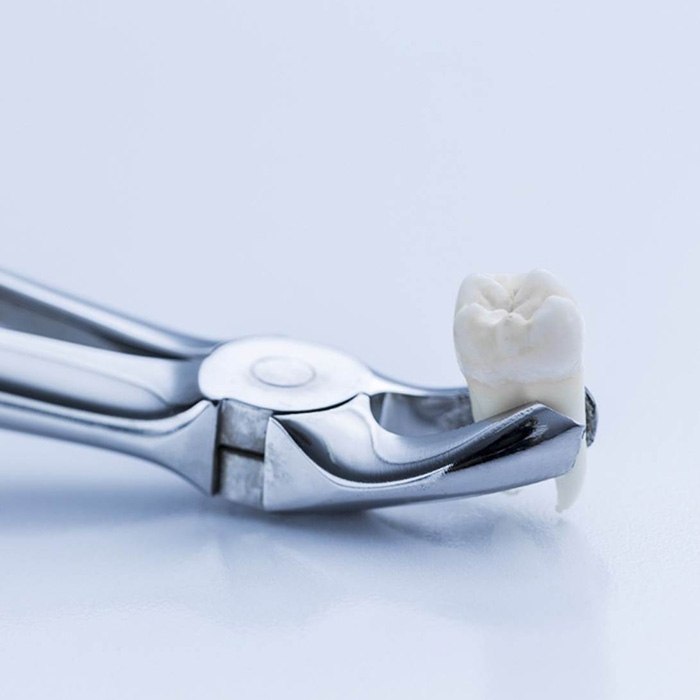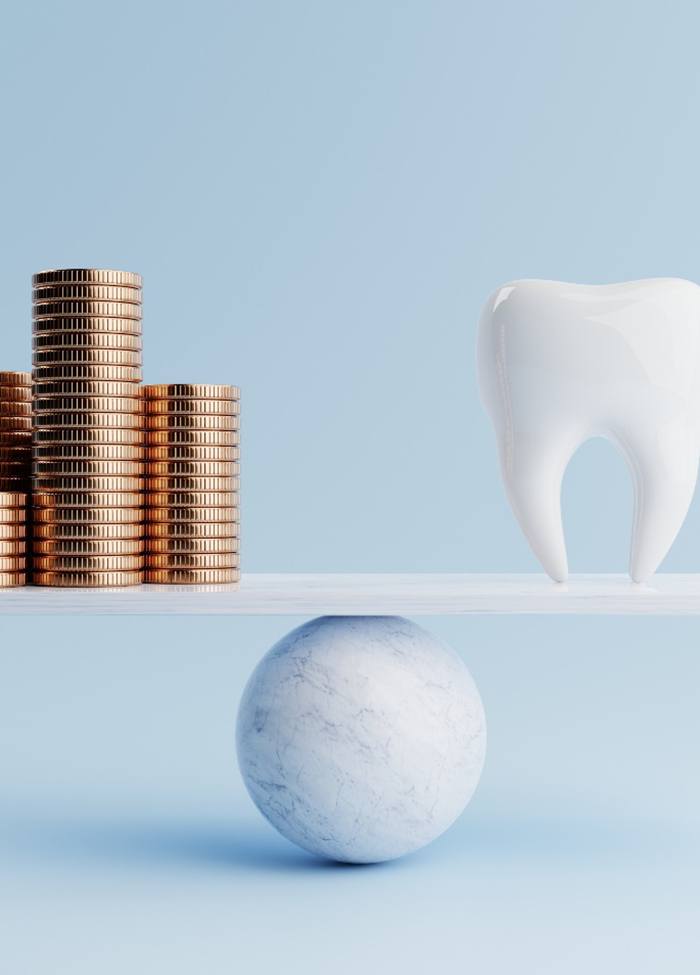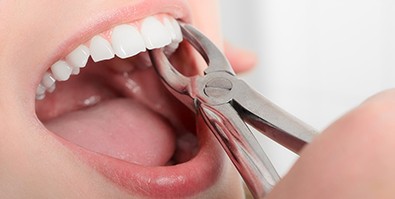Tooth Extractions – Grand Prairie, TX
Removing Compromised Teeth to Restore Your Oral Health

Our goal at The Grand Prairie Dentist is to preserve your natural pearly whites at all costs. However, in cases where a tooth is damaged beyond repair, we can perform tooth extractions to prevent problems like decay or infections from spreading and wreaking havoc on your surrounding teeth. Dr. Deepti Namineni can easily remove the affected tooth, and our team can work with you to replace it with a dental implant crown, bridge, or denture to restore your smile.
Why Choose The Grand Prairie Dentist for Tooth Extractions?
- Dentist with Over a Decade of Experience
- Start-to-Finish Dental Implant Treatment
- We Treat Dental Patients of All Ages
Reasons Why Tooth Extractions Are Necessary

We don’t recommend tooth extractions lightly. However, some instances in which we’ll likely suggest this treatment include:
- A tooth is damaged or decayed beyond repair, like an infection that has spread to the roots of a tooth and can no longer be addressed with root canal treatment.
- Gum disease has led to the supportive bone and gum structures deteriorating, causing loose teeth.
- A tooth is impacted below the gumline and is at risk of becoming infected.
- Crowded teeth make it to where there isn’t enough room in the mouth to undergo orthodontic treatment.
- An accident has caused a tooth to become cracked.
The Process of Removing a Tooth

If we determine that we need to remove your tooth – whether it’s at your routine checkup or an emergency appointment – you can rest assured that we will go above and beyond to make the treatment process as smooth and comfortable as possible. After explaining what to expect and answering any questions you have, we will thoroughly numb the area of your mouth surrounding the tooth so you don’t feel any discomfort. Then, we will carefully rock it loose with dental forceps. Once it’s ready to come out, we will remove it and tend to the extraction site.
Important note: If the tooth that needs to be removed is trapped underneath the gumline, then we will take a slightly different approach by creating a small incision in your gums first.
Tooth Extraction Aftercare

Getting plenty of rest following your procedure is extremely important. To avoid complications like dry sockets and infections, we recommend:
- Not exercising, spitting, or drinking through a straw
- Taking OTC pain medication as directed on the label
- Drinking plenty of water to stay hydrated
- Eating soft, nutrient-dense foods, like oatmeal
- Keeping your mouth clean
- Changing your gauze as needed
If you want to learn more about tooth extractions – from what to expect during the procedure to how to heal comfortably – don’t hesitate to get in touch with us so we can provide further information!
Understanding the Cost of Tooth Extractions

Now that you're familiar with the process of tooth extraction, you're likely interested in the cost. Given that it’s a significant procedure, it’s natural to want to manage your expenses. The price can vary depending on your unique circumstances, making it difficult to provide an accurate estimate in advance. However, after a consultation with Dr. Namineni, you'll receive a detailed quote that will help you understand the procedure and its cost so that you can make an informed decision.
Continue reading below to learn more about what impacts the price of your tooth extraction, and feel free to contact our friendly office staff with additional questions.
Factors That Can Affect Tooth Extraction Cost

Before we can determine the final amount due, Dr. Namineni must complete an oral examination to identify what will be needed to successfully extract your tooth. Some factors that can influence the total include:
- The location of the tooth. Molars in the back of your mouth are larger and harder to access, so they tend to cost more to remove than your front teeth.
- The type of extraction. A simple extraction involves numbing the area and then withdrawing your tooth with forceps. A surgical extraction is more expensive because it’s more complex and requires additional staff, medication, and instruments to complete.
- How you’re replacing it. Once your tooth is successfully taken out, you’ll need to fill in the gap with dentures, a dental bridge, or a dental implant. Each of these methods has its own pricing.
Does Dental Insurance Cover Tooth Extractions

Many dental insurance policies cover approximately 50% of the cost of your extraction, but there are usually limitations. For instance, you may need to meet your annual deductible before the plan starts covering the cost. There might also be a waiting period before certain treatments are reimbursed. Some plans may have other restrictions, such as coverage for a specific number of teeth. Understanding these details can help you plan your dental expenses more effectively.
It’s important to check with your provider to ensure you understand what’s included in your policy. If you’re unsure or would like help finding out, please let us know! We’re familiar with many insurance plans and are happy to help you with any paperwork needed to make the most of the benefits available to you.
How to Make Tooth Extractions More Affordable

We understand that extractions can be expensive, but we believe that your budget shouldn’t keep you from getting the essential dental care you need. As a result, we’ve partnered with CareCredit, a third-party financer. If you’re approved for the program, you can break down your total payment into more manageable installments that work for your wallet.
We’re more than happy to work with you to ensure that you can afford treatment. If you have additional questions or need assistance with applications, we’re more than happy to accommodate you!
Tooth Extractions FAQs
Does Getting a Tooth Extracted Hurt?
If you need a tooth extraction but have been putting it off because you’re worried about a long and agonizing procedure, you’re not alone. Many people procrastinate getting the care they need if they’re concerned about whether it will hurt.
Fortunately, regardless of how many teeth need to be removed, our team will do everything we can to ensure that you remain comfortable and relaxed throughout the process. First, we’ll apply a local anesthetic to numb the area. If you’re still feeling overly anxious or have a hard time sitting still for long periods, we can also provide sedation so that you can safely undergo the surgery.
You may feel some pressure during the procedure itself, and it’s normal to experience some mild swelling and inflammation afterward. However, if your pain worsens or you develop a fever or other signs of infection, please contact us right away so we can ensure that everything is healing as intended.
What’s the Recovery for Tooth Extractions Like?
Our team will provide you with detailed post-op instructions after your tooth has been removed to help you heal as quickly and efficiently as possible. It’s important to follow these orders carefully to avoid developing any issues.
For example, one essential component of recovery is forming a blood clot over the extraction site. You should avoid doing anything that can damage or dislodge it, like participating in strenuous activities that elevate your heart rate or drinking through a straw. If this clot is harmed or pushed out of place, you could develop a painful complication known as dry socket.
It’s also imperative that you keep your mouth clean to prevent a potential infection. In the first three days after your appointment, you can gently rinse with salt water until it’s safe to resume brushing and flossing your teeth.
What Are My Options for Replacing a Missing Tooth?
Dr. Namineni can recommend an appropriate replacement method based on your unique circumstances. The best treatment for you can vary based on how many teeth you are having extracted and where they are located in your mouth. A more detailed description of each of the options is outlined below:
- Dental bridges. These prosthetics are usually recommended if you’re having 1 or several teeth pulled in a row. They contain the correct number of pontics, or artificial teeth, with a dental crown on either end. These will be cemented over the healthy teeth on either side of the gap in your grin.
- This versatile solution can be adapted to meet your needs regardless of how many teeth are missing. A partial set can seamlessly restore your smile’s appearance and functionality, while a full set can completely rebuild your grin.
- Dental implants. These are often considered the ideal way to replace lost teeth because they’re the only prosthetic that’s implanted directly into your jawbone. As a result, they come with several advantages over the alternatives and can last 30+ years with the right care.
Can I Leave the Space Empty After a Tooth Extraction?
Many patients wonder whether it’s safe to leave the gap in their grin after their tooth has been removed, whether it's due to their budget or anxiety over dental visits. This is especially true if it’s located in the back of their mouth where no one will see it.
The truth is, though, that missing teeth can impact more than just your appearance. Spaces in your smile can have a detrimental impact on your oral and overall health. For example, you rely on your teeth to chew your food thoroughly. If some are missing, you might be unable to break down your meals sufficiently enough to be digested and could develop gastrointestinal issues. You might also have a harder time enunciating certain words or sounds to be clearly understood.
Once your mouth has healed from your extraction, we encourage you to schedule your next appointment with Dr. Namineni to discuss which replacement method works best for you.
